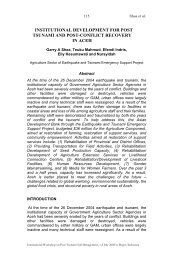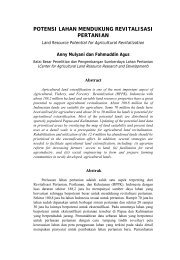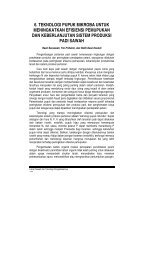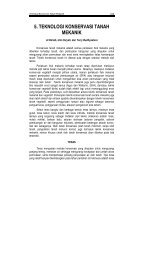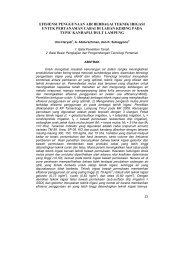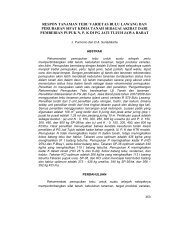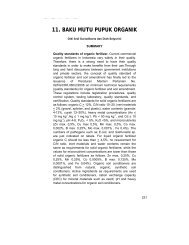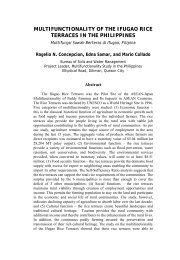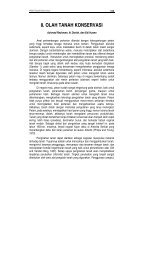Proceedings - Balai Penelitian Tanah
Proceedings - Balai Penelitian Tanah
Proceedings - Balai Penelitian Tanah
Create successful ePaper yourself
Turn your PDF publications into a flip-book with our unique Google optimized e-Paper software.
134<br />
McLeod et al.<br />
Table 1. Ranges of ECe values for surface and subsurface soil layers in<br />
2005 and 2007<br />
Soil Layers (m)<br />
Equivalent ECe values ranges (dS/m)<br />
Aug 05 Jan 07<br />
0 - 0.45 0.8 - 33.7 0.8 - 23.4<br />
0.45 - 1.5 1.0 - 21.8 1.1 - 23.0<br />
Figure 2. Average ECa at the soil surface (EMh) at selected<br />
measurement times. Numbers above bars indicate the<br />
location of measurements<br />
Factors affecting soil salinity levels include length of seawater<br />
inundation period after the tsunami, land use/soil type, exposure to<br />
tidal movement, and the availability of irrigation water and drainage<br />
infrastructures.<br />
Soil salinity levels were higher in the areas that were inundated with<br />
sea water for a longer period after the tsunami (Figure 3). The length<br />
of seawater flooding after a tsunami relates to the thickness of saline<br />
mud sediment and water infiltration into the soil profile. Tsunami mud<br />
sediment was found to be thicker in areas that were flooded for a<br />
longer period. The tsunami mud collected from BPTP ground in Banda<br />
Aceh in January 2005 is extremely saline (EC1:5 value of 6.3 dS/m,<br />
equivalent to a ECe value of about 54 dS/m).<br />
Variation of tsunami-induced soil salinity between soil types/land uses<br />
is related to soil texture. Lowland rice fields with heavier textured soils<br />
were more saline than sandier and more permeable dryland fields.<br />
Lowland rice farming practices require the formation of an<br />
impermeable claypan at about 20 cm depth to hold water during the<br />
growing season. However, this layer also inhibits the downward<br />
leaching of salts after a tsunami. This suggests the critical role of<br />
surface drainage in leaching salts horizontally out of the lowland rice<br />
International Workshop on Post Tsunami Soil Management, 1-2 July 2008 in Bogor, Indonesia



